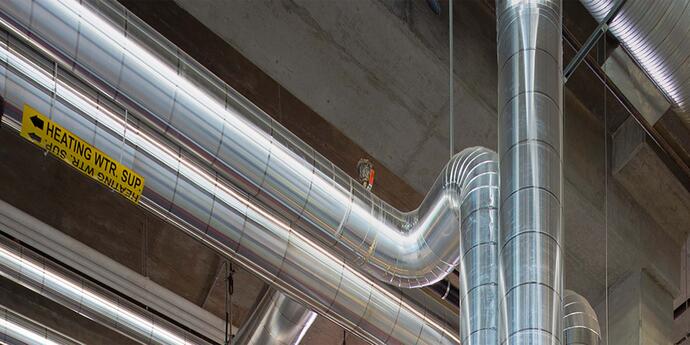In the shadow of COVID-19 variants, many areas of Canada continue to see lockdown orders reflective of cresting case numbers. As local, provincial, and federal governments navigate mounting questions connected to public health and safety, building owners and operators are forced to answer increasingly varied questions surrounding the safety of indoor public and private spaces.
We first published an article addressing the topic of Limiting the Spread of Airborne Pathogens through Mechanical Design in May 2020. While the body of knowledge surrounding COVID-19 has grown since that time, many of the key considerations listed remain the same. As engineers, we have a responsibility to balance pragmatism with innovation – to avoid generalizations, carefully consider all possibilities, and advise the best possible approach for each client. This responsibility includes remaining informed on the latest available information surrounding the transmission of SARS-CoV-2, providing updates on the impact that mechanical design decisions can have on mitigating the spread of this virus.
We thought it would be a good idea to revisit these mechanical design recommendations, taking a look at how some technology is stacking up in light of what we now know, and what could still be a consideration in the future as building occupancy levels continue to fluctuate.

What We All Now Know About COVID-19 (That We Didn’t Know a Year Ago).
Over the past year, we have seen increased research surrounding the likelihood of airborne transmission of SARS-CoV-2. The World Health Organization and the American Society of Heating, Refrigerating, and Air-Conditioning Engineers (ASHRAE) have each provided additional statements surrounding the behaviour of this virus as an aerosol; these updates also appear to apply to the variants that have since emerged. The WHO has issued several statements since the summer of 2020, providing increased certainty surrounding the aerosol transmission of the virus. Earlier this year, the Government of Canada updated their statement regarding COVID-19 modes of transmission to include the spread from an infected person through droplets or aerosols, “which linger in the air under some circumstances.” In April 2021, the ASHRAE Epidemic Task Force released a new statement on this issue, advising that:
“Airborne transmission of SARS-CoV-2 is significant and should be controlled. Changes to building operations, including the operation of heating, ventilating, and air-conditioning systems, can reduce airborne exposures.”
While peer-reviewed research surrounding transmission patterns still does not indicate that the HVAC system is a transmission pathway for SARS-CoV-2, changes to the HVAC system (and to building operations procedures overall) could have an impact on what is now confirmed to be spread through the air (in addition to direct, indirect, and close contact with an infected individual).
As the updated statement from the ASHRAE Epidemic Task Force alludes to, when we talk about HVAC design in relation to the transmission of SARS-CoV-2, it is a mitigation discussion. Containing the virus still occurs on a person-to-person level, with the use of masks and social distancing measures critical to such containment.
Even outside of pandemic circumstances, mitigating the potential spread of airborne pathogens is a key consideration of mechanical system design. There are practical changes that can and should be prioritized, and there is also continued discussion around emerging approaches that could open new doors.
Recommendations, Revisited.
It remains important to keep in mind that each building is unique. While broad recommendations would certainly be more straightforward, the reality is that solutions must be proposed on a case-by-case basis. What works well for one building may not be reasonable depending on the use cases of building occupants (as well as owner cost restrictions).
The design solutions that we discussed last year remain sensible approaches worthy of consideration. Given what we now know about the transmission of SARS-CoV-2 – and pulling from experience designing healthcare environments across the country – two considerations have emerged as strong recommendations, with additional possible options depending on the condition of existing systems (as well as the needs of users).
Strongly Recommended: Review of Ventilation Rates
If it’s been a while since you’ve reviewed your ventilation rates against occupancy expectations, now would be the time to engage a mechanical engineer to help you do so. This is something that can “drift” over time, and it’s critical that buildings are meeting ASHRAE 62.1 ventilation rates. This drifting is connected to “manual” adjustments that may be made by operations teams year after year, necessitating a review to make sure the rates align with ASHRAE 62.1 standards. Increased ventilation rates beyond this standard may be beneficial as it can further dilute recirculated air, but a review of the existing equipment would need to take place in order to confirm that the equipment could handle an increase beyond the recommended rates. There may also be an energy efficiency trade off with over-ventilating, which should be a consideration if looking to go beyond ASHRAE 62.1. Measuring CO2 in an area with high occupancy levels would provide a good indication of the existing ventilation rates, and would help outline the necessary next steps.
Strongly Recommended: Review of Filtration
In occupied conditioned spaces, you need MERV-13 filtration or better in place on recirculated air systems. Where existing air handling systems can’t be upgraded to handle MERV-13 filters, supplementary technology may be an effective consideration. Some of these optional considerations are outlined below; whether they are a right fit for a particular building must be decided on a case-by-case basis. For example, Smith + Andersen’s Toronto office has MERV-13 filters and currently has carefully controlled occupancy; as we’ve tested the particulate count of this office in recent months, we have continually seen counts which equate to “clean room” quality air. Increased occupancy levels in our office space in the future could provoke the consideration of additional measures, but for now our needs are met and the space is set up well to limit the spread of airborne pathogens.
Optional: Ultraviolet (UV) Filtration
As discussed in our previous article, UV light can be used inside air handling units and ductwork to disinfect coil and duct surfaces – a practice that has been utilized in some buildings but is not very common. This can help remove contaminants from the air before it is circulated to the space, but does not impact the presence of contaminants already within the space. The limitations surrounding UV often involve safe management and maintenance, as well as life cycle costs (to maintain efficacy, the lamps must be replaced according to manufacturer’s recommendations, which is typically once per year). Following a thorough risk assessment, building managers may find the use of UV light inside air handling units to be a useful solution in conjunction with additional mechanical design reviews and improvements. Last June, our electrical team also published an article addressing UV disinfection. This article discusses both in room solutions and ventilation applications, outlining the potential associated risks and best applications in greater detail. The use of UV, in any capacity, requires proper operations and maintenance procedures in place.
Optional: Bi-Polar Ionization Filtration
This technology has gained a significant amount of attention over the past year. Manufacturers of Bi-Polar Ionization (BPI) filtration, or “active” filtration, claim that the technology sends polarizing particles into a space, initiating coagulation of smaller particles into larger particles, thus enabling easier capture by filters. The associated technology varies widely, and it’s important to know the appropriate standards to look for when considering vendors, as well as the appropriate technology to align with the application. Following discussions with several vendors, we decided to test the needlepoint bi-polar ionization technology within the S+A Toronto office space. Through this testing, as well as the ongoing review of other independent studies, we have identified some considerations surrounding the use of this technology in an office environment. Occupancy levels, duct air velocity, duct distribution length, airflow capacity, and the levels of filtration and ventilation already incorporated in the space are all considerations. It’s also important to remember that this technology does not directly address the spread of airborne pathogens – it is focussing on one factor (mitigating particulate count) among a wide range of ventilation considerations.
Optional: Increased Relative Humidity
During the initial spike of COVID-19 cases, relative humidity was a frequently discussed topic as a potentially effective solution in decreasing the transmission of some infectious diseases. While this research is compelling, the Canadian climate does not make this a very attractive solution for many indoor environments. To be effective in limiting the spread of a virus like SARS-CoV-2, an increase in relative humidity to between 40 and 60% in buildings would be required. Unfortunately, this is not a tenable solution for spaces contained within conventional building envelopes at colder Canadian temperatures. Even in new buildings, this is a difficult range to achieve and, in most Canadian climates, achieving this range while avoiding condensation or frosting on the interior of the envelope is not typically possible. Still, there is qualified research behind the efficacy of this option and there could be instances, or built environments, where this type of solution makes sense in conjunction with other measures. For example, interior humidification levels can be increased and monitored based on outdoor conditions while still preventing condensation from occurring.
With a little help from my friends…
A lot has changed over the past year – vaccines have been developed and are rolling out, and many parts of the world are moving toward a slow return to normalcy. Still, a lot remains unknown. It is not unreasonable to expect that even more change is in store, and the demand to respond to such change will escalate quickly.
The best approach? Be prepared. There are many variables to consider, and there is no substitute to working one-on-one with a trusted mechanical engineer, tailoring a solution to the needs of your building (or portfolio of buildings) in a way that will help you react to the unpredictable. We are all working toward the same goal: a safe return to working, learning, and connecting in shared spaces across the country.

















